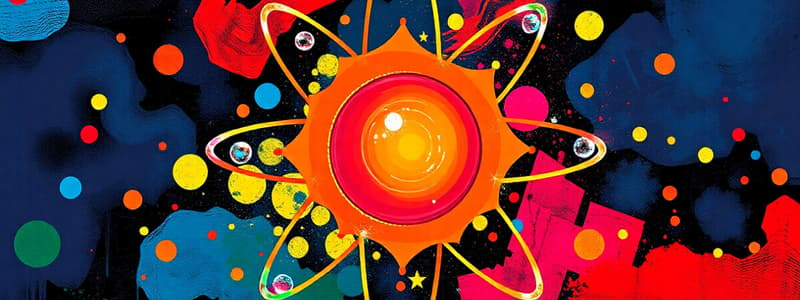Podcast
Questions and Answers
Which of the following statements about atoms is incorrect?
Which of the following statements about atoms is incorrect?
- The number of protons in an atom's nucleus determines the element.
- Atoms are the smallest unit of an element that retains the chemical properties of that element.
- Atoms can be divided into smaller particles that still retain the chemical properties of the original atom. (correct)
- Atoms are composed of subatomic particles called protons, neutrons, and electrons.
What is the primary factor that determines the identity of an element?
What is the primary factor that determines the identity of an element?
- The total number of protons and neutrons in an atom
- The number of protons in an atom (correct)
- The number of electrons in an atom
- The number of neutrons in an atom
Which subatomic particle carries a positive charge?
Which subatomic particle carries a positive charge?
- Proton (correct)
- Neutron
- All subatomic particles carry a charge.
- Electron
What is the relationship between the number of protons and the number of electrons in a neutral atom?
What is the relationship between the number of protons and the number of electrons in a neutral atom?
What determines the mass number of an atom?
What determines the mass number of an atom?
Which of the following statements accurately describes isotopes?
Which of the following statements accurately describes isotopes?
What is the significance of the atomic number of an element?
What is the significance of the atomic number of an element?
What is the primary reason for the difference in chemical properties between isotopes of the same element?
What is the primary reason for the difference in chemical properties between isotopes of the same element?
Flashcards
Atom
Atom
The fundamental building block of matter, composed of protons, neutrons, and electrons.
Subatomic Particles
Subatomic Particles
Particles that make up an atom: protons, neutrons, and electrons.
Nucleus
Nucleus
The dense central part of an atom containing protons and neutrons.
Proton
Proton
Signup and view all the flashcards
Electron
Electron
Signup and view all the flashcards
Isotopes
Isotopes
Signup and view all the flashcards
Atomic Number
Atomic Number
Signup and view all the flashcards
Mass Number
Mass Number
Signup and view all the flashcards
Study Notes
Introduction to Atoms
- Atoms are the fundamental building blocks of matter.
- Atoms are incredibly small, with diameters typically ranging from 0.1 to 0.5 nanometers.
- All ordinary matter is composed of atoms.
- Atoms are composed of smaller subatomic particles: protons, neutrons, and electrons.
Structure of the Atom
- Atoms have a central nucleus containing protons and neutrons, surrounded by a cloud of electrons.
- The nucleus is incredibly dense compared to the electron cloud.
- Protons carry a positive electrical charge.
- Neutrons have no electrical charge, making them neutral.
- Electrons carry a negative electrical charge.
- The number of protons in an atom's nucleus defines the element.
- The number of protons and neutrons collectively determines the atom's mass number.
- Electrons orbit the nucleus in various energy levels (or shells).
Properties of Subatomic Particles
- Protons and neutrons have approximately the same mass, which is much larger than the mass of electrons.
- The mass of an electron is significantly smaller than the mass of a proton or neutron.
- Protons and neutrons reside within the nucleus; electrons exist in regions surrounding the nucleus called electron clouds or orbitals.
- The arrangement of electrons in orbitals determines the chemical properties of an element.
- Normally, the number of electrons equals the number of protons, keeping the atom electrically neutral.
Isotopes
- Isotopes are atoms of the same element with different numbers of neutrons.
- They have the same number of protons and electrons, maintaining their chemical properties, but differing in mass number.
- Different isotopes of an element can exhibit varying stability.
Atomic Number and Mass Number
- The atomic number represents the number of protons in an atom's nucleus.
- The mass number represents the total number of protons and neutrons in an atom's nucleus.
- The atomic number uniquely identifies an element.
Atomic Mass
- Atomic mass, often listed on the periodic table, is the average mass of an element's naturally occurring isotopes.
- It takes into account the relative abundance of each isotope.
Arrangement of Electrons
- Electrons occupy specific energy levels (shells) around the nucleus.
- Each shell can hold a maximum number of electrons.
- Electrons within the same shell have similar energy levels.
- Inner shells are filled first.
- Electrons in the outermost shell are called valence electrons, crucial for chemical bonding.
Atomic Models
- Various models explain the structure of the atom.
- Examples include the Bohr model, depicting electrons orbiting the nucleus in specific paths, and the quantum mechanical model, describing electrons as existing in probability orbitals.
Matter
- Matter is anything that occupies space and has mass.
- Matter is composed of atoms.
- Different arrangements of atoms lead to various states of matter (solid, liquid, gas, plasma).
- The properties of matter result from how atoms are arranged and bonded.
- Different elements exhibit different properties due to their atomic structures.
Studying That Suits You
Use AI to generate personalized quizzes and flashcards to suit your learning preferences.




